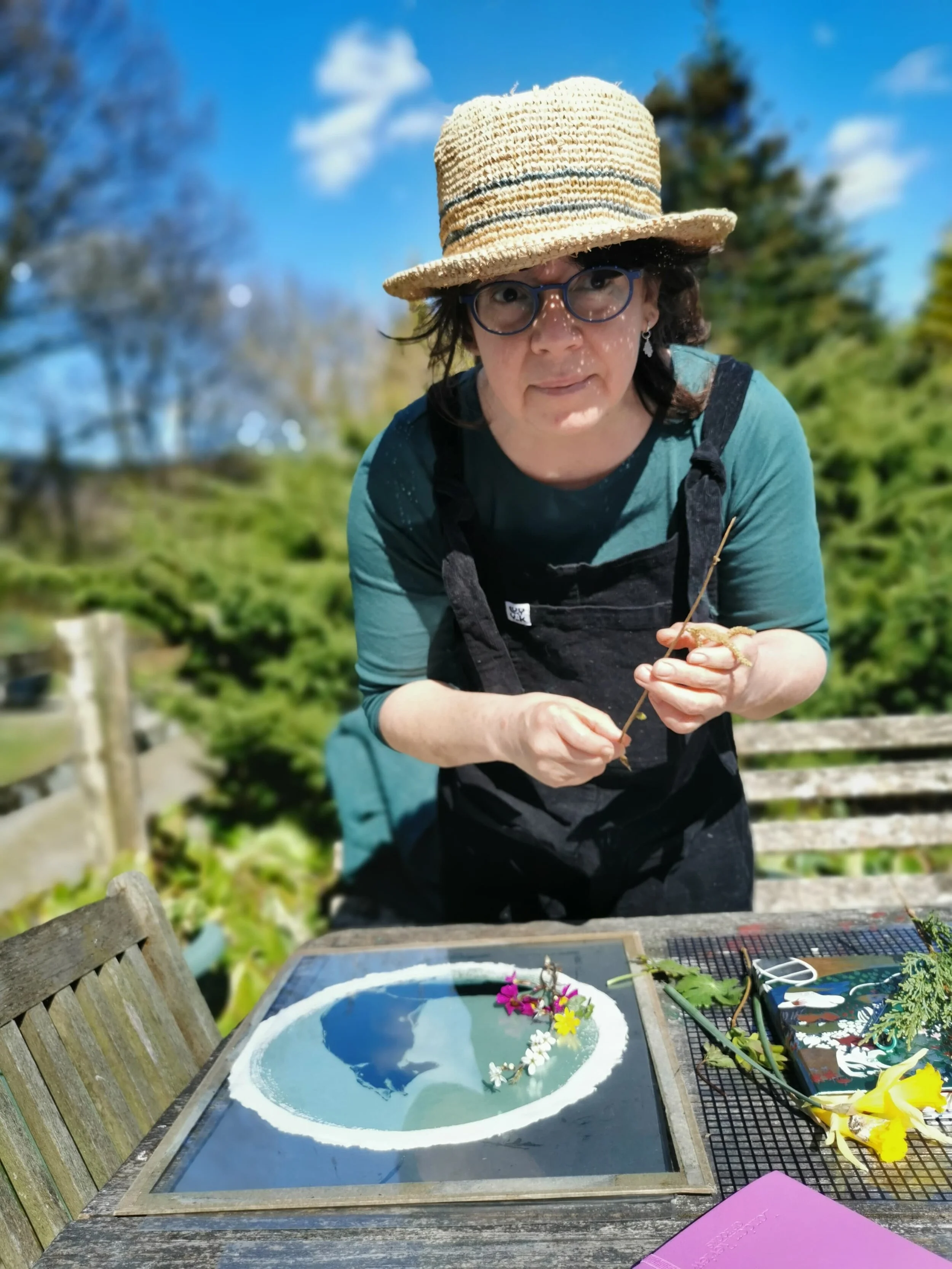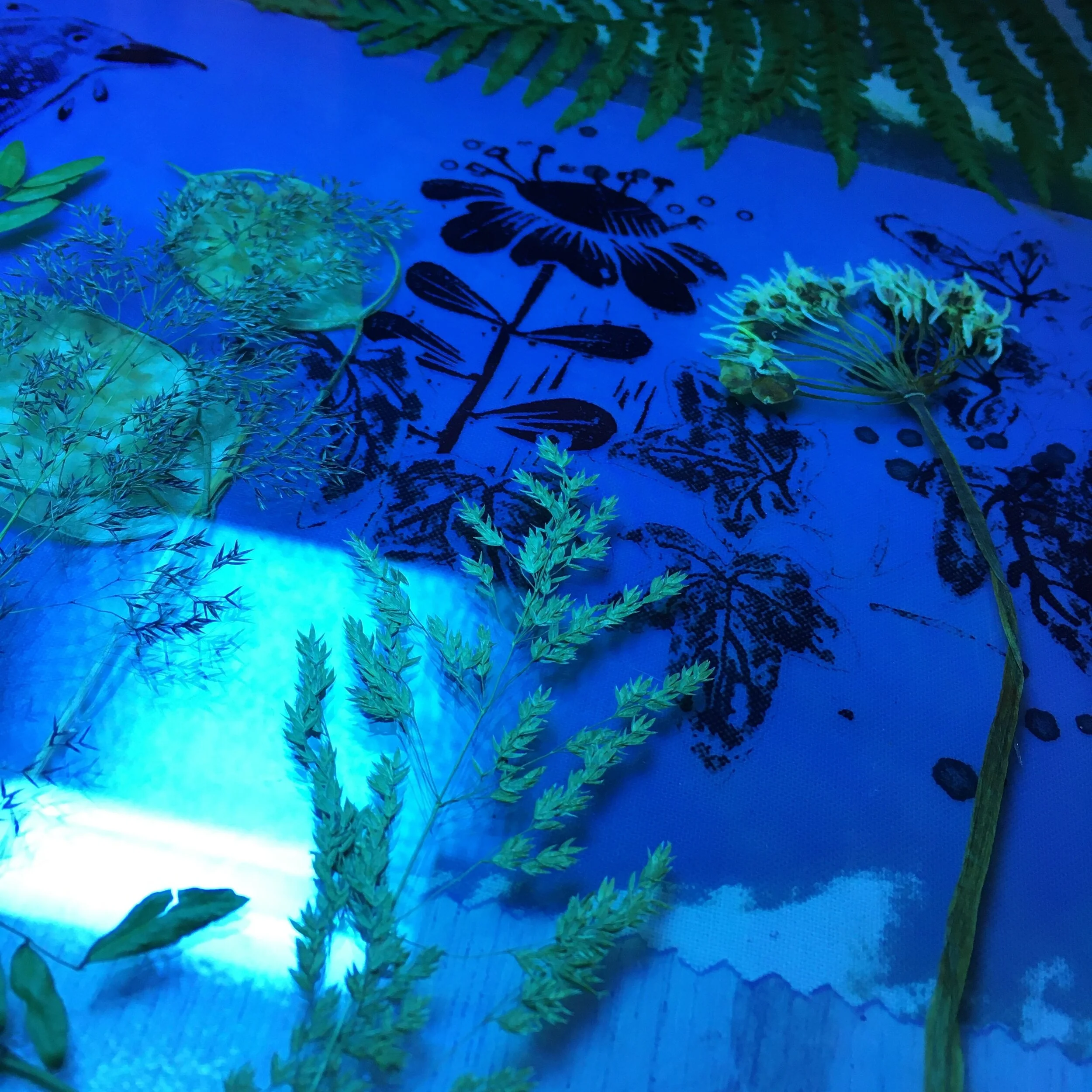What is this blue magic? An introduction to cyanotype.
Often, when I’m at an exhibition or an art fair, I hear people telling each other how I’ve made my work, “it’s indigo” is the most common explanation and since they often think I can’t hear their conversation and I don’t want to frighten them, I don’t always leap up and correct them!
Sometimes it’s nice to keep secrets and I hope it’s the imagery and not just the process that interests people but I thought it might be useful to give a bit of background information on the cyanotype process because it really is quite special.
Kim making prints on Khadi paper, Spring 2020.
So, what is a cyanotype? First discovered in 1842 by John Herschel, the cyanotype process was developed around the same time as Photography and is now called an “Alternative Process”. Pioneers of the process, such as Anna Atkins (who is credited with having made the first photographically illustrated book) used cyanotype photograms to make accurate botanical studies. There is a wonderful book about her, “The Bluest of Blues” by illustrator Fiona Robinson, it is aimed at children but gives a lovely introduction to Atkin’s life and work so I often use it in my workshops.
A photogram of Algae, made by Anna Atkins as part of her 1843 book, Photographs of British Algae: Cyanotype Impressions, the first book composed entirely of photographic images.
After finishing my degree in Textiles and Surface design in 2009 I suddenly realised I would have no access to screen printing equipment and couldn’t afford digital prints so I started experimenting with cyanotype on paper and fabric as a way to make images I could stitch into ( I was a freelance embroidery designer at the time). In The Sketchbook Project, 2012, part of the Brooklyn Art Library, I started using the light sensitive solution as paint on some of the pages, combined with my drawings. Fast forward to the present and after years of making cyanotype art and teaching print workshops I’m excited that in 2024 Search Press commissioned and published my book about the process.
A page from my sketchbook in The Sketchbook Project, 2012.
So how is it done?
Prints can be made on fabric, paper or any other surface which has been coated with a light sensitive emulsion (as the blue marks on my kitchen table prove!). There are lots of different recipes, some come ready mixed and you can even buy pre-coated “Sun print paper” but I like to mix my own solution.
Coating fabric with prepared solution.
Design elements such as stencils, photographic negatives, plants, feathers and other objects are placed on the surface to block the light and once prepared the paper is exposed to sunlight (or a UV light source)and starts to oxidise, changing colour from pale yellow to a dark grey/green.
Print developing under UV light - including prepared negative and collected plants.
Once developing is complete the print is rinsed in running water and then left to soak and washed again to make sure all the yellow solution has been removed. The washing stops the process and fixes the image so that it is now permanent. This is the moment of truth when you either have a beautiful image in etherial shades of blue and white or it hasn’t quite come out right and it’s time to start again before the clouds cover the sun!
Once I’ve made a print I’m happy with I will often stitch or paint into it and occasionally use tannins such as those found in black tea, to tint the image with sepia shades. Prints on fabric are made into lanterns and shades which are also finished with decorative and functional stitching. Each piece goes through many stages before ending up on a gallery wall and unlike other forms of printmaking each image is unique.
If you’d like to make your own blue magic I have kits with everything you need to get started here and you can order a signed copy of my book “A Beginner’s Guide to Cyanotype” Search Press, May 2024 here. You can also ask for it in your local independent bookshop or public library (did you know authors get a tiny payment when their books are borrowed?)
The book is available in the US,Canada and Australia and has just been translated into French!





